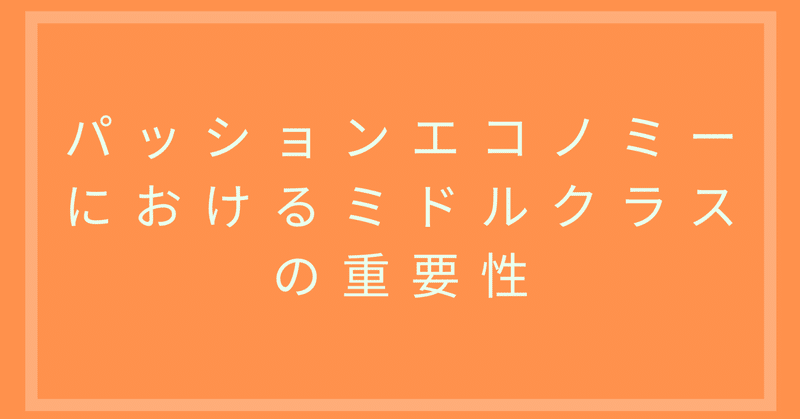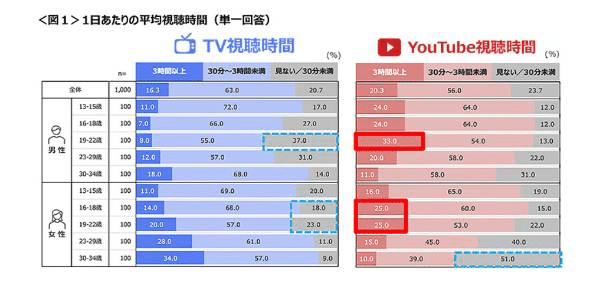
パッションエコノミーにおけるミドルクラスの重要性
こんにちは、アメリカで統計を勉強しており、パッションエコノミーファンのけんたです。
毎週、海外パッションエコノミー関連レポートをLINEでお届けします。以下から友達追加お願いします。Twitterもやってます。
LINE: https://lin.ee/xm1HKAC
-----------------------------------------------------------------------------
元a16zのベンチャーキャピタリストで、パッションエコノミーという言葉を世界中に広めた立役者のLi Jinさんが最近Harvard Business Reviewにクリエイターエコノミーにおいての中流層(ミドルクラス)の重要性とどのようにその層を支援していくかという内容の記事を寄稿しました。
この記事では、クリエイター要素のある提供側を持つプラットフォームを強化していく上でのさまざまな戦略がまとまっています。
元記事のタイトルは"The Creator Economy Needs a Middle Class"となっていますがここでのCreatorはプラットフォーム上で供給側にいるグループ全体を指しています。
少し長い内容になっていますが今日は引用や訳、自身の見解など入れながらこの記事について書いていきます。
トップ層への成功の集中とミドルクラスの重要性
最初にいかにプラットフォームのトップ層が多額の富を築いているかという例がいくつか載せられています。
"Just last year, YouTube creator David Dobrik’s monthly AdSense checks from the platform were $275,000 for an average of 60 million views. On Substack, the top 10 creators are collectively bringing in more than $7 million annually. Charli D’Amelio—who recently became the first TikTok creator to surpass 100 million followers—is estimated to be worth $4 million at age 16. She started on TikTok just 1.5 years ago...On Patreon, only 2% of creators made the federal minimum wage of $1,160 per month in 2017. On Spotify, artists need 3.5 million streams per year to achieve the annual earnings for a full-time minimum-wage worker of $15,080, a fact that drives most musicians to supplement their earnings with touring and merchandise."
上記の例全てには触れませんが、最初はトップYouTuberのDavid Dobrikについてです。彼は一時期、月平均6000万再生を叩き出し、月々の広告からの収益は$275,000(2750万)だったようです。
"The sustainability of nations and the defensibility of platforms is better when wealth isn’t concentrated in the top 1%. In the real world, a healthy middle class is critical for promoting societal trust, providing a stable source of demand for products and services, and driving innovation. On platforms, less wealth concentration means lessening the risk that a would-be competitor could poach top creators and threaten the entire business."
しかし、国家の持続性とプラットフォームの優位性のためには富がトップに集中しておらず、しっかり中流層がいるのが理想です。現実社会では、その方が経済的に安定し、イノベーションも起こりやすい。プラットフォームの観点では上流層頼りだと、その層が去るとたちまち競合に追い抜かれてしまいます。
"Rosen argued that in markets with heterogeneous providers, like most creator economies, success accrues disproportionately to those on top: 'lesser talent often is a poor substitute for greater talent \[...\] hearing a succession of mediocre singers does not add up to a single outstanding performance.'"
1981年の論文で、シカゴ大学の経済学者Sherwin Rosenさんはテクノロジーの発達の影響で「スーパースター現象」がより起こりやすくなるということを述べています。
彼は、クリエイターエコノミーのような、供給サイドのひとりひとりが他と異なる場合、個人の特徴や能力の差により少数の人に成功が集まる傾向があると分析しています。なぜなら、「才能の低い者はより才能のある者の代替えになりにくい」からということです。彼は例として「平均的な歌手達の歌を連続して聞くことは1人のすごい歌手のパフォーマンスには敵わない。」ということを言っています。
(反対に、Uberなどの場合ドライバーそれぞれの違いは収入などにはあまり影響がありません。この点が供給が統一的にコモディティ化されたUberなどのGig EconomyとPassion Economyの違いですね。)
"This phenomenon is further exacerbated by technology which lowers distribution costs: the best performers in a given field are freed from physical constraints like the size of concert halls—and can address an unlimited market and reap a greater share of revenue"
さらに、トップに富が集中しやすい要素として、テクノロジーの発達による流通コストの減少が挙げられています。トップ層はもうコンサート会場のキャパのような物理的制約から開放されており収入などの上限は無くなったようなものです。
"Creator platforms flourish when they provide opportunity for anyone to grow and succeed"
ですが、プラットフォームはだれにでも成長して成功できる機会が提供できると成功する、ということですね。
”The middle class in America didn’t just happen naturally, but was born of 20th-century policies that created widespread prosperity: Roosevelt’s New Deal; the Fair Labor Standards Act, which established the minimum wage, overtime pay, and prohibition of employment of minors; a rise in unionism; the passage of the GI Bill; and the creation of the Federal Housing Administration. These policies shifted the balance of power to workers, distributed opportunity for wealth creation, and mitigated growing income inequality, helping to build a strong middle class that comprised 61% of American adults by the end of the 1960s."
現実社会では、実際過去にはアメリカではニューディール政策、労働基準法などの政策で60年代終わりまでには中流階級が成人人口全体の61%にまで成長し活気づいたたそう。
"Some inequality is inherent in the nature of the passion economy: supply is heterogeneous and non-substitutable, and the trust and affinity that creators build with their audiences should be celebrated. But platforms—from established to brand new—can do more to strengthen the creator middle class and broaden the path to success"
クリエイターが自分のユニークさを活かして築きあげる信頼や関係は歓迎されるべきことですが、プラットフォームにもそういった不平等になりがちな傾向を抑制し、トップ以外のクリエイター層も強化する方法があるというのがこの記事のメインのトピックになります。より多くの人に機会を拡大させる手段として10つの戦略が下記です。

1. Focus on content types with lower replay value(リプレイの価値が低いコンテンツに力を入れる)
"How many times can a person listen to the same podcast episode? Probably not many before the content becomes repetitive and boring. In contrast, one can listen to a favorite song on repeat ad infinitum... This suggests that categories with high replay value—like music and game platforms—are most susceptible to concentration among a few mega-hits"
例えば、音楽などはお気に入りのものだと何回も再生しても飽きないということがあります。そのような場合、消費側が同じものを消費し続け少数のコンテンツに人気が集中しやすくなります。
"To create a more equitable creator ecosystem, platforms can direct users to content types where there’s greater appeal in experiencing a wide array of content."
反対に言えば、いろいろな種類のコンテンツを楽しむことが単一のコンテンツを楽しむということより魅力的であれば、消費側がより多くのクリエイターに支払うことに繋がります。
2. Serve heterogeneity in user preferences & empower niche(消費側の好みの違いを活かし、ニッチなコンテンツをサポートする)
"Rosen’s theory of superstar economics is predicated on “imperfect substitution among quality differentiated goods”—great surgeons who can save 10% more lives get much more than 10% incremental demand. This highlights an attribute of various content categories that I’ll call objectivity of quality: some content categories have more definitive, universal quality standards than others. The “best” test- prep tutor could be possibly ascertained through measures like test scores, while there may not be a universally “best” fan fiction author, as user preferences vary widely"
先ほどのRosenさんの論文では、質で違いのある製品間では、10%品質のいい商品は質の悪い商品と比べ10%以上多い需要を得るという前提がありました。
これに対しLi Jinさんはカテゴリーによっては統一された品質の基準がないと言っています。例えば、家庭教師の評判などはテストの点数がどれだけあがるか、という客観的な評価で質が決まります。しかし、フィクション小説などは主観的に評価されるので読者の好みの違いによって、家庭教師などと比べると統一された基準ができにくいということですね。
"When various segments of users have different preferences and opinions on quality, there’s a greater opportunity for a diverse array of creators to succeed. Platforms can encourage creators and consumers to explore and develop these niches"
ということは、プラットフォームが消費側の多様性に沿ったコンテンツの製作を促進できれば、供給、消費側双方にとって多様でニッチなコンテンツの製作に繋がります。
"For example, the online children’s education marketplace Outschool sends teachers a weekly email that aggregates parents’ requests for new class topics, with dozens of new requests each week like 'Painting a Goldendoodle' and 'Scooter lessons and tricks.' This feature helps creators understand what niches would be fruitful for offering a class"
こどものためのオンラインクラスのマーケットプレイスのOutschoolは先生達(供給側)に、こどもの親からの新しいクラスのリクエストを毎週メールでリストとして送っているそう。
このように、供給側が消費側のニーズをよりわかりやすくしくみがあるとコンテンツの多様性やより多くのクリエイターの収入増加に繋がりやすくなります。
クリエイターや有名人に誕生日のお祝いビデオなどをリクエストして作ってもらえるプラットフォームのCameoでは、ユーザーがその人のお気に入りのクリエイターに直接特定のビデオのリクエストを送るという仕組みになっています。クリエイターはそのリクエストにそってビデオを撮るので、そのコンテンツはそれぞれのユーザーのニーズにとてもパーソナライズされたものになります。
“One person’s D-List is somebody else’s favorite person in the world.”
ある人にとっては全く有名じゃない人でも他の誰かにとっては世界で1番のお気に入りの人、とCameoのCEO、Steven Galanickさんも言っています。
3. Recommend content algorithmically with an element of randomness(アルゴリズムでコンテンツを、時にはランダムに、レコメンドする。)
"Some theories on why the long tail hasn’t flourished in a world of infinite digital products are that customers find it hard to know what to search for, and that most recommendation systems are basic, simply recommending what other users have consumed/purchased. The weakness of this system is that users rarely see anything outside of their interest areas and can get locked into filter bubbles; popular creators are further amplified, making it challenging for newcomers to break out"
ほとんどのレコメンデーションアルゴリズムはユーザーに他のユーザーが消費したものを勧めるものが多く、ユーザーは自身の興味外で新たに好きなコンテンツを発見することが難しくなっています。
"However, when algorithms do the searching for users, there are more opportunities for niches to thrive... notably, TikTok also stated that combatting filter bubbles and introducing diversity into the feed were direct goals, and it did so by injecting different videos into the For You Page that don’t match what users have engaged with before"
しかし、TikTokは完全にアルゴリズムベースのフィードがメインでユーザーに多くの新しいタイプのコンテンツをレコメンドします。
新規のクリエイターにとってこれは特にプラスの側面の方が大きくなります。
まず、このランダム性はフォロワーが少ないクリエイターにも一定数のユーザーからの試聴時間を与えます。そして、そのユーザーの反応を基準にそのコンテンツの価値が決定されるので、トップクリエイターの既存のフォロワー数などの影響が他のプラットフォームよりも弱くなっています。
そして、それはコンテンツの質さえよければアルゴリズムがそれを検知し多くのユーザーにおすすめしてくれるということを意味します。要は、コンテンツの質の比重が高く、他のプラットフォームよりバズるという現象が多く起こります。
しかし、この点はユーザーの興味に沿ってのレコメンド(Exploit)と新たにユーザーの興味を開拓するレコメンド(Explore)のバランスも重要になってきます。
TikTokは一動画が長くても数十秒とExploreに失敗した時のユーザー体験が悪くなるコストがYouTubeやNetflixよりも低くなっています。コンテンツの消費にかかる時間や費用などによってこのExploreのコストが変化します。
New @ScreenshotEssay today:
— Eric Stromberg (@ericstromberg) November 12, 2020
TikTok, Instagram, and the Quadrant of Deep Understanding pic.twitter.com/7mBbPcmSEP
4. Facilitate collabs and community(コラボやコミュニティーを促進する。)
"In Daniel Pink’s 2001 book Free Agent Nation, he writes, 'Free agents may be bowling alone, but they’re not going it alone \[...\] loyalty hasn’t disappeared; it has simply changed from vertical to horizontal.' He was referring to the broad trend towards self-employment in America and the necessity of building out a strong network of peers in a world without company-provided networks. The exact same can be said today about content creators"
作家のDaniel Pinkさんは著書、Free Agent Nationで、伝統的な会社の縦のネットワークの外で、単独で活動している個人の横のネットワークの重要性について書きました。
"Collaborations drive creator growth and success in a number of ways: Because content consumption is driven, in part, by which creators a user already follows, creating content together is an opportunity for cross-promotion"
YouTubeでYouTuber同士がコラボをすると双方がより多くの視聴者に見てもらえたり、登録者数が増えやすくなるというのはわかりやすい例です。
先程、TikTokのアルゴリズムがランダム性があり、良いということに触れていましたが、その大きな理由は小さなクリエイターでもユーザーに見てもらえる確率が高いからということでした。
そのゴールは縦のコラボを促進することによっても達成することが可能です。
よくSNSですでに影響力のあるアカウントが規模の小さなアカウントのことについて話し、そのアカウントのフォロワーが急に増えるということがあると思います。
新鋭のクリエイターが人気のクリエイターとコラボできると、同じ現象が起きやすくなります。この仕組み作りができると消費側もより多くのクリエイターを目にする機会が増え、新規のクリエイターも育ちやすくなります。
"Teachable’s online teacher community provides a dedicated space for creators to network with others who are in a similar business phase. Given the lack of formal colleagues in this new unbundled work world, creators are well-served through alternative sources of community"
オンラインコースプラットフォームのTeachableはクリエイター同士でのコミュニケーションが発生する様にクリエイター専用のコミュニティーを運営しています。
5. Provide capital investment to up-and-coming creators(新鋭のクリエイターに金銭的な投資を提供する)
"If creators are the new small businesses, what is the new version of small business lending? Some creator verticals require upfront capital or investment to unlock the next level of growth, and could benefit from funding in order to lower the barriers to entry. While the returns on being a successful creator may not be venture scale, there could be new models like social tokens or niche creator-focused funds that provide a bundle of funding and education"
小さなビジネスのサポートをするように、まだ規模の小さなクリエイターの将来性に投資をすれば、より多くのクリエイターがプラットフォームでアクティブに活動でき、成功した時の金銭的なリターンやプラットフォーム自体の強化に繋がります。
ここでの質問事項の一つになってくるのがコンテンツへの投資額とコンテンツのクオリティーが比例するかということです。
例えば、YouTubeやInstagramをはじめとするプラットフォームの成功の一因として生産コストとコンテンツの価値が比例していないということがあります。
極端に言えば、視聴者が求めているコンテンツがわかる才能とカメラさえあれば、だれでもYouTubeチャンネルを開設でき有名になったり収益が発生してくるということです。
視聴者にとって低コストでとられたYouTubeビデオがとてもお金のかかっているテレビ番組よりも主観的価値が高いということは最近の若い人はテレビよりもYouTube、ということが表しています。(もちろん理由はそれだけではないですが)
もちろん、お金がある方がコンテンツ製作をしやするなるということもあると思うのでプラットフォームによっては全く効果がないということはないと思います。
"Podfund, in the podcasting vertical, is an example of the latter, providing funding between $25,000-$150,000 to podcast studios and high-potential creators in exchange for a revenue share"
記事であげられている例としては、ポッドキャストのクリエイターに投資しているPodfundです。
Podfundは他の多数のプラットフォームの様にクリエイターに金銭的サポートをレベニューシェア(利益をあらかじめ決めておいた配分率で分ける)と引き換えに提供しています。TikTokのCreator Fundなども有名です。
6. Decouple creator payouts from audience demographic(クリエイターの支払いを消費側の人口的属性から切り離す)
"Unlike most other platforms, the TikTok Creator Fund de-couples content from commercial imperatives, a dynamic that both Hank Green and I have explored. On TikTok, Creator Fund payouts are driven by engagement and views... in contrast, YouTube—which pays creators 55% of ad revenue shown on their videos—incentivizes creators to make content for an affluent, advertiser-friendly audience. The higher the advertising rates and the more sought-after the audience is for advertisers, the more creators earn on their videos... Likewise, on Instagram, the prevailing monetization model of affiliate links and brand sponsorships incentivizes creators to cater towards a high-income audience... the Creator Fund stems from rewarding creators that generate the highest engagement, rather than those that generate the highest spend."
YouTubeやインスタグラムの主要な収益化方法は広告によるスポンサーからきています。そして、コンテンツのタイプによってもちろん主要な視聴者層が変わります。それにより、それぞれのコンテンツタイプのスポンサーに対する価値も変わり、一部のカテゴリーのクリエターは他のカテゴリーより稼ぎやすくなるということが起こります。
それに対し、TikTokのCreator Fundはカテゴリーに関係なくコンテンツのエンゲージメントによって報酬を支払っています。
もちろん、カテゴリー間での平均エンゲージメントの差もありますが、広告主を中心に運営されているプラットフォームに比べ、クリエイター側がカテゴリーに縛られることなく収益がが期待できます。
7. Allow creators to capitalize on superfans(スーパーファンからの収益化を簡単にする)
"On YouTube, creators earn just $3 to $5 per 1,000 video views. In contrast, Twitch subscriptions are tiered at $4.99, $9.99, and $24.99 per month. If each Twitch subscriber accounts for one view, it’s a monetization rate that’s at least 1,000x more than YouTube’s revenue per mille (RPM)."
YouTubeでは1000ビューごとの広告収益は3ー5ドルと言われています。それに対しライブストリーミング配信プラットフォームのTwitchなどのサブスクは月5、10、25ドルほどなので、ファン一人一人からの支払いのレートが単純計算で1000倍以上になるということ。
これは1ビュー=1サブスクとカウントしているので少しフェアではない気がします。
しかし、広告ベースだと1人のファンが大ファンでもその人の試聴1回はほかの人の試聴1回と同じ価値になります。
やはりその点、熱狂度に応じて違う額を集められるサブスクは1ユーザーあたりの単価が高くなり、必ずしも大勢のファンがいなくても収益が出てくるということには繋がりやすくなります。
"What are other types of products that can decouple monetization from audience size? Subscription fan communities (e.g. Mighty, Circle), paid access to creators (e.g. on Cameo, Looped, OnlyFans), and sales of high-value products such as courses and e-books can help creators with modest audiences to thrive"
Mighty NetworkやCircleのサブスクや、Cameo、Looped、OnlyFansなどの一部の熱心なファンがクリエイターに支払うことを可能にしているプラットフォームがこのスーパーファンからの収益化を簡単にしているプロダクトの例です。
8. Create passive (or almost-passive) income opportunities for creators(受動的所得の機会を作る)
"In the real world, the most common middle-class jobs in America include primary school teachers, truck drivers, nurses, and sales supervisors. What’s the commonality of all these professions? They all have non-zero marginal costs: to treat one more patient or make one more sale entails more time and effort"
先生やトラック運転手などの中流層の仕事の特徴はNon-zero marginal cost(ゼロでない機会費用)です。それは、生産量を増やすためには総費用も比例的に増やす必要があるということです。
"This stands in contrast to the digital content world, wherein creators have zero marginal costs for additional viewers. While near-zero marginal costs cause digital superstars to accrue massive audiences, the lack of marginal costs can also work in favor of emerging creators, who are able to sell digital goods with little marginal effort/time"
それとは反対に、デジタルの世界では一度コンテンツを作ると追加のインプットなしで何度でも何人にも試聴や買ってもらうことが可能です。
先程あった様に、特にリプレイの価値が高いとコンテンツはトップ層が巨大なファン層を獲得することにつながることもあります。が、この機会費用の低さはデジタルコンテンツを製作するだれに対しても当てはまるので、新鋭のクリエイターも総費用を増加させずに生産量を増大させることができます。
なのでプラットフォームとしてクリエイターがデジタル商品の製作や販売ができるようにツール面などでサポートできると、それほどクリエイターからの追加のインプットを求めずとも収益が増加しやすくなるということに繋がります。
9. Offer a form of Universal Creative Income (UCI)(UCI(ユニバーサル・クリエイティブ・インカム)の様なものを提供する)
"there’s plenty of reasons why people don’t take the leap into self-employment, despite 71% of Americans expressing a preference for self-employment over being an employee. The top obstacles are financial in nature: Freshbooks’ 2019 Self-Employment in America Report revealed that the top barriers to self-employment were: “worry about inconsistent income” (35%), “don’t have cash to invest” (28%), and “worry about earning less” (27%).”
こちらは先程のクリエイターに金銭的投資をする、ということと似ている様に感じます。先程のTikTokのクリエイターのためのファンドも定期的に投稿することを条件にクリエイターに一定の資金も提供しています。この様な追加の資金的サポートはクリエイターの資金面での心配を減らしよりリスクと取りやすくしたり、コンテンツの生産に集中してもらいやすくする効果が期待できます。
これは最近メディアで話題にも上がる国民全員のの最低限の収入を政府が保証しようというUBI(ユニバーサル・ベーシック・インカム)の様なアイデアです。
プラットフォームの観点から言うと、インセンティブなしでただ資金提供となると、全くなにもコンテンツが生産されないままお金だげがなくなるということになるので、保証と生産促進のバランスが難しいところです。
10. Provide creator education and training(クリエイターに教育やトレーニングを提供する)
これは個人的に金銭的サポート以上にプラットフォームとして重要な要素かと思います。
先ほどもふれた様に、デジタルプラットフォームの根本的特徴としてテレビなどより、より能力主義になっているのでプラットフォーム上で成功するための1番の要素は自分で高品質のコンテンツを製作し宣伝する力です。
なので、プラットフォームとしてそれぞれのクリエイターにそのプラットフォームで成功するためのハウツーを教育することができると当然より多くのクリエイターが成功します。
さらに、それはより多くの競合を産むので全体のコンテンツの質向上に繋がります。
そうすると、また競争が激しくなり何か新しいスタンダードを作り人気になるクリエイターがでてきます。これはプラットフォームの性質ですね。
In China, influencer incubators take this educational angle to the next level, and have a multi-step model focused on developing, growing, and monetizing influencers (called key opinion leaders or KOLs).
中国での例として、インフルエンサーを養成するインキュベーターが挙げられています。コンテンツの作り方やフォロワーとのコミュニケーションの仕方、メイクの仕方まで教育している様です。
"Substack’s Bridge mentorship program is a two-month program that pairs together emerging and established Substack writers. The program promises that mentees will 'get help with their editorial strategy and business; and sharpen their creative skills around writing style, asking for feedback, and positioning their value.'"
アメリカの例としてはSubstackのBridgeプログラムです。このプログラムではSubstackですでに人気のライターが親衛のライターのメンターになりサポートするというものです。
以上が、ミドルクラスのクリエイター層を育てるための10つの戦略です。
"Societies and platforms flourish when there is a path for everyone to have upward mobility, achieve financial security, and learn and grow."
社会やプラットフォームはクリエイター全員にとって流動性や、収益化、学びや、成長する機会があると成長する。
この記事は現実社会とデジタルの経済圏の共通点と違いにふれながら、どのような戦略がより多くのクリエイターに成功してもらうために必要か、ということがまとめられていました。実際に、これらの戦略はどんどんこれから新しいプラットフォーム上で試行錯誤されていくと思います。
-----------------------------------------------------------------------------
もしこちらの記事を楽しんでいただけたら、スキやシェアなどしていただけるとありがたいです。
毎週、海外パッションエコノミー関連レポートをLINEでお届けします。以下から友達追加お願いします。Twitterもやってます。
LINE: https://lin.ee/xm1HKAC
この記事が気に入ったらサポートをしてみませんか?

